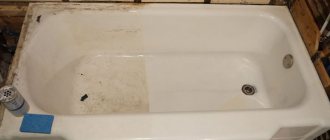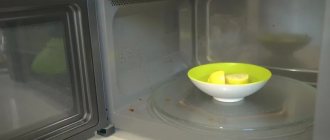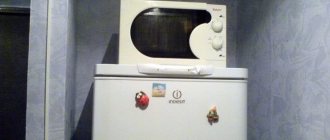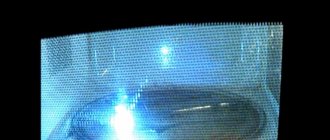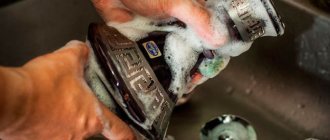/Order/
All of the most effective and fastest ways to clean the inside of a microwave are based on one principle - creating a steam bath and a trap for cleaning agent fumes. The trap effect will be created by the stove itself, but our task is to make an effective cleaning solution from products that, fortunately, you probably already have in your kitchen cabinet.
A quick way to clean a microwave
In most cases, the vinegar “bath” method helps to clean the microwave from old greasy deposits and stubborn stains:
- Mix 1.5-2 cups of water and 2 tablespoons of vinegar (9%) in a bowl and put it in the microwave.
- Start the microwave oven at maximum power for 10 minutes, then leave it to “steam” for another 5-10 minutes.
- Wipe the oven with a damp cloth to remove dirt and vinegar odors.
Yes, the smell of vinegar will be felt during cleaning, but it will quickly disappear both from the room and from the microwave chamber. And, of course, during the “bath” it is advisable to open the window.
If the dirt has become wet after the “bath”, but still remains, you can turn on the oven for another 10 minutes or wipe its chamber with a sponge soaked in the same vinegar solution and sprinkled with soda.
Old greasy deposits after a vinegar “steam room” can be washed off with olive oil.
Now let’s talk about other ways in which you can replace or supplement the cleaning method described above.
Properties
The liquid with a sour taste and pungent odor has antibacterial properties, which is why it is used for cooking or canning food. Acetic acid prevents the growth and reproduction of dangerous microorganisms - salmonella bacteria, E. coli, mold, dust mites and many others. Therefore, this disinfectant is used in everyday life no less often than in cooking:
- as a cleaning agent - removing traces of adhesive tape on plastic or glass, removing rust, wax residues from wood or fabric, stains from carpets;
- as a detergent - removing various types of dirt from pots, refrigerators, microwaves, dishes;
- to remove limescale – on metal and ceramic surfaces;
- deodorizing the room - neutralizing odors appearing in food containers, refrigerators, trash cans, and on cutting boards after cutting “fragrant” foods;
- to remove stains on clothes.
Using acidic liquid in everyday life has a number of advantages:
- Safety - after treating a table, window sill or other object in the house, there is no need to worry that a child or pet will touch it. This is the difference between vinegar and special products, particles of which (if not rinsed with water enough) enter the body and can cause poisoning. When producing detergents, various fragrances and fragrances are added to them, which often contribute to the development of contact dermatitis - allergies. Such a nuisance is eliminated if you use vinegar during cleaning.
- Versatility - with the help of an acidic product you can disinfect almost all household items.
- Cost-effective – vinegar, while not inferior in cleaning properties to the finished product, is much cheaper.
REFERENCE!
For household purposes, it is advisable to use a product obtained by diluting synthetic acetic acid (table 5-9% acid solution). Natural vinegar is more expensive and is better left for cooking.
We described in this article how to clean a microwave oven from carbon deposits and grease at home using other methods.
Method 3. Cleaning the microwave with soda (for medium dirt)
If you don’t have citric acid on hand, and you don’t grow a lemon tree at home, and generally prefer to use citrus fruits for their intended purpose, then baking soda will help you, as it will settle on the walls of the chamber in the form of condensation and dissolve dried splashes and dirt.
What you need: water (400-500 ml), a container for water and 1 tablespoon of soda.
Recipe: our task is to make a solution that will settle on the walls of the chamber in the form of condensation and dissolve dried splashes and dirt. To do this, fill the dish with water, pour soda into it, put it in the chamber to heat at maximum power for 2-5 minutes, and then leave the oven alone for another 5 minutes. Then all that remains is to wipe the camera clean, in difficult places, wetting a sponge or rag in the same soda solution.
General rules
Microwave ovens are presented today in the widest range. But when cleaning contaminants of any model, you should follow the general recommendations:
- When wet cleaning external and internal walls, use a minimum of water. Try not to let liquids get into the functional openings, otherwise the “kitchen helper” will fail.
- If you do flood the oven, do not turn it on for the next 3-5 hours to allow excess moisture to evaporate. It is better to leave the device alone all night.
- Wash removable parts separately - soak them in a soapy solution (dishwashing gel is suitable), rinse under running water and wipe dry.
- Clean glass or clear plastic doors with soapy water and then spray them with window cleaning spray to make the finish shine.
- Do not use products containing hard particles to clean stubborn grease; they will leave streaks on the surface. The same applies to brushes and scrapers - it is prohibited to clean surfaces with them.
- Don’t forget to wipe the outer walls of the device - not only grease, but also dust accumulates here.
Advice! Crushed activated carbon will help get rid of the smell in the microwave. It is left in the cleaned chamber for 7-10 hours with the door closed.
Method 4. Cleaning with vinegar (for severe stains)
Vinegar will help clean even the most neglected microwave oven effectively and quickly, but you will have to endure the smell during the cleaning process. And one more thing - if the chamber of your microwave oven is covered with enamel, then we do not recommend using this method too often.
What you need: water (400-500 ml), a container for water and 2 tablespoons of vinegar (9%) or 1 teaspoon of 70% essence.
Recipe: First of all, open the window slightly so that the smell of acid can disappear. Next, pour water into a plate, pour the bite into it, put the solution in the chamber and turn on the microwave for 2-5 minutes, depending on the degree of contamination. Now we give the vinegar evaporation a little more time to dissolve the dirt on the walls of the chamber and begin to wash the inside of the microwave oven with a sponge or soft brush. When you're done, rinse your equipment clean of the product itself.
Features of cleaning a microwave depending on the type of internal coating
Contamination of the inside of a microwave oven with grease due to frequent use is a natural phenomenon. However, when choosing the most suitable option for removing contaminants, it is necessary to take into account the effect of the product used on the inside of the device. It is important that the procedure does not result in destruction of the protective layer.
If the inner surface is covered with enamel, it is not recommended to use vinegar too often. Baking soda also quickly removes dirt; you can use it.
Method 5. Cleaning the microwave using a sponge and Fairy (for light and medium dirt)
You probably thought that we would be talking about ordinary mechanical cleaning? Not at all, although you can’t do without it, but now we offer a slightly different method that is suitable for washing a slightly dirty microwave.
What you will need: any sponge (except metal, of course), water for soaking it, as well as any dishwashing liquid like Fairy, Dosi, etc.
Recipe: squeeze out a detergent the size of a 1-ruble coin onto a sponge generously soaked in water, then foam it well, squeezing and unclenching the sponge. Next, put it in the chamber and start the microwave at minimum power for 30 seconds, making sure that the sponge does not start to melt. Now open the door and wash off the grease and splashes softened by the steam of the product with the same sponge. In the following video you can clearly see the process and result of cleaning using the described method.
See also the material: How to clean an automatic washing machine from dirt and scale in 5 steps.
Pros and cons of the procedure
Vinegar microwave cleaning has a number of advantages and disadvantages.
Pros:
- Availability, cost-effectiveness. Vinegar is an inexpensive product that can be purchased at almost any store.
- Effective in combating pollution. Vinegar breaks down fats well, and they dissolve more easily in water.
- Safety. With the exception of stainless steel, most microwave ovens respond favorably to vinegar.
- Disinfectant action. Vinegar helps eliminate mold and kill most germs that accumulate on appliance surfaces.
- Hypoallergenic. The product is relatively safe for health, does not poison the body with toxins, does not pollute the environment, and reduces the risk of allergic reactions.
One of the disadvantages of vinegar as a cleaning agent is its pungent odor. To eliminate it, it is enough to ventilate the room.
Vinegar can cause skin irritation. Therefore, it is better for people with sensitive skin to work with vinegar solution in rubber gloves.
Method 6. Cleaning the microwave with a glass cleaner (without a “bath”)
Here’s another good and technology-safe method of cleaning using household chemicals, albeit without creating a “bath” effect.
What you need: a sponge, water, and any glass cleaning liquid.
Recipe: First, unplug your oven. Next, mix a cleaning solution of glass cleaner and water in a 2:1 ratio. The solution should be enough to clean the oven both outside and inside. Next, generously soak a sponge in the cleaning solution and wipe the inside of the microwave, including the ring and plate. Dried stains should be soaked in glass cleaner for 5 minutes. Next, thoroughly wipe the entire chamber with a clean cloth soaked in water so that there is no dirt, no windshield wiper residue, or its smell left on the walls.
Preparing the device
The microwave oven is an electrical device, so cleaning should only be done after it has been disconnected from the power supply . The only exception is “steam” cleaning, for which the microwave oven must be powered.
How to prepare a microwave for hygienic work:
- Disconnect the device from the network - remove the plug from the socket. If the model has knobs that count time, return them to the zero position.
- Remove all removable parts of the chamber - the glass stand for dishes and the ring with wheels.
- If possible, move the device away from the walls or remove it from the stand to wash the surfaces around it.
Advice! It doesn’t hurt to arm yourself with the factory instructions and carefully study the section on cleaning the oven inside and out.
Do you often cook in a slow cooker?
Of course not
Method 7. How to clean a microwave with orange peels
The method is excellent for removing light and medium stains. The advantages are obvious: a pleasant citrus smell that will spread throughout the apartment, and there is no need to thoroughly rinse off the remnants of the “product”, as is the case with chemicals.
What you need: 1 orange, water, bowl and sponge.
Recipe: Peel the orange, place the peel in a small bowl, fill it with water, put it in the microwave and run it for 5 minutes. During this time, the water should boil, and condensation will form on the walls. Next, you need to wait another 10-15 minutes and only then start washing the oven. Drops of fat will come off quite easily.
Rules of care
Before you start cleaning, read the general rules for using a microwave oven:
- Do not wipe with rough cloths or hard brushes. Hard bristles can leave scratches, which subsequently neutralize the protective layer of the microwave oven.
- When washing, carefully bend around the ventilation grill so that no drops of water get into it. Failure to do so may result in a short circuit.
- Before cleaning, unplug the oven for safety reasons.
- To prevent stubborn stains on the interior surface, do a weekly “general” cleaning.
- Wash (wipe) the inside surface of the electrical appliance every time after use.
- To avoid stains, cover dishes with a special lid.
- Do not place anything on the case, especially containers with liquid contents, so that they do not tip over and flood the equipment.
Advice from experienced housewives
Experienced housewives advise:
- If you do choose a commercial cleaner, you should try to purchase a product that smells weak. After cleaning, leave the door open for several hours. Use caution when using any chemicals inside the microwave oven.
- Never use pre-moistened cleaning cloths in the microwave because the cloth may catch fire.
- The more you use your microwave, the more often it requires cleaning up. However, on average, cleaning once every two weeks is an appropriate schedule if you want to keep your microwave looking and smelling like new.
